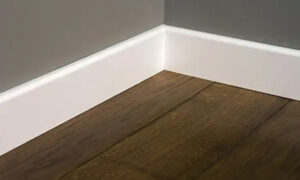
Crown molding can handily add that just-right decorative touch to any room.
Crown molding can handily add that just-right decorative touch to any room, but!: there must needs be a bit of thought behind the decision process regarding which type is best suited to your unique/particular aesthetic and other relevant circumstances. You’ll need to, first instance, consider the material’s durability, cost, the extent to which it goes with what you already have.
There are myriad(ish) commercially-available options, but the current top two picks for crown molding are easily PVC and wood. Read along below to learn all both so that, when the time comes, you’ll know which is the better choice for your project.
PVC Crown Molding
PVC is a “human-made” material (i.e., ya won’t find it in the wilderness) and an affordable option for homeowners on a budget. This molding is highly resistant to moisture, making it an excellent choice for bathrooms or other areas with lots of humidity. PVC is lightweight, flexible, and easy to cut, and therefore a naturally popular choice for DIYers.
However, PVC is prone to damage as result of exposure to excess heat or sunlight, and so, not suitable for areas near windows or large glass panels of any sort. One might also reflect that it lacks that “authentic” appearance of natural wood, which may be a drawback for some homeowners (and prospective homebuyers).
Wood Crown Molding
This is a more traditional option, and perfect for those who just cannot get enough of that certain aforementioned je-ne-sais-quoi natural wood rightly emanates. Wood, you’ll unlikely be shocked to read, comes in all manner of styles, cuts, grains, etc., including (perhaps most popularly) oak and pine, and allots an expansive creative freedom/malleability for elaborate features and design endeavors. It’s easy to prime and paint, and you can always sand it down if you don’t like the look.
However, wood is susceptible to damage from water, termites, and what we’ll go ahead and call “general rot,” making it relatively difficult to maintain in tip-top shape without dedicated/regular TLC. But despite this vulnerability, wood is indeed durable and can last for many years if well taken care of. Perhaps the more significant downside of wood is that it can be costly, with some types going for up to as much as $30 per foot. Note that the cost may be especially “worth it” for eco-conscious homeowners, as wood is 100% sustainable.
Closing Thoughts: A Quick Review
When it comes to a direct comparison between PVC and wood crown molding, the former shines as an excellent option for budget-conscious homeowners and for areas with high humidity, but admittedly lacks the (-come on, you know this is the right word:) enchantment of natural wood—which may well be a deal-breaker for certain folk. -And wood is of course an excellent option for, well, those particular folk; it’s elegant, it’s sophisticated, it’s… enchanting. But also more costly, and needs more maintenance. Ultimately, the crux of the decision lies in determining what you want (look, features…) as factored alongside what you need (budgetary and other “logistical” concerns). Remember, an expert is always right around the (virtual) corner to offer (actual) guidance on any and all molding matters.
Purchase Your New Molding from Fisher Lumber
Be sure to visit Fisher Lumber’s Designer Showroom featuring displays of Andersen Windows, Therma-Tru entry doors, Simpson and Masonite exterior doors, and a wide selection of interior doors featuring Simpson, Masonite, Lemieux, and JELD-WEN. Our knowledgeable experts are ready to assist you! Contact us at 301-424-6500 and follow us on Facebook, Twitter, and Pinterest.
